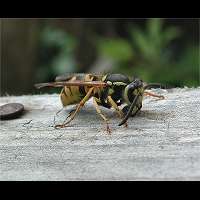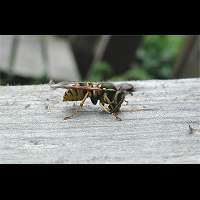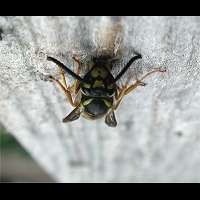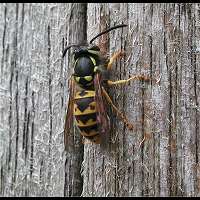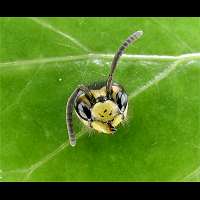[All pictures of garden wildlife on this page are thumbnails. Click on any thumbnail for a large format to be displayed.]
German Wasp (Vespula germanica)
The German Wasp is black with yellow lines. It is extremely similar to the Common Wasp. The best way of telling the females apart is by looking at the black spot in the yellow clypeus. There are usually three small black spots (rarely one) and it is never anchor-shaped as it is in case of the Common Wasp. The males can only be identified by studying their private parts under the microscope. The German Wasp is the bigger of the two, but only just. Queens have a bodily length of 17 to 20mm. Workers reach a length of 12 to 16mm and the males usually are some 13 to 17mm long.
The queen of the German Wasp starts constructing her nest very early indeed: by the beginning of April. It is normally made underground in a abandoned mouse nest or even a mole hill, but may be contructed at dark places in buildings etc. Rarely in a hollow wall, though. The German Wasp uses dry, weather-beaten wood to produce the paper the nest is constructed with. That is why the nest is always greyish and never brownish. Because of this choice in wood the animals are regularly seen chewing on old, unpainted wooden fences, poles and garden furniture. Sometimes accompanied by Red Wasps, for this species uses the same materials. The nest maybe over 2 metres long and contains up to 14 combs. The air chambers on the outside have one opening, which is facing downwards. The nest of the German Wasp is one of the very few in possession of more than one entrance. The nest may hold 10.000 animals in total at its peak. Near the entrance of the nest the German Wasp is far less aggressive than the Common Wasp is. But that is the only plus. In autumn at a terrace it doesn't matter which of the two species appear: both are readily stingers when someone is between them and their food.
The German Wasp is better adapted to warm climates than the Common Wasp. Thus it doesn't live in Europe and Northern Asia only, but can be found in more southern parts of Asia and in Northern Africa as well, but not in the Tropics. It has been introduced into New Zealand and Australia, the Andes in South America, Southern Africa and the eastern parts of the USA and Canada. A very common species all over the British Isles.
The queen of the German Wasp starts constructing her nest very early indeed: by the beginning of April. It is normally made underground in a abandoned mouse nest or even a mole hill, but may be contructed at dark places in buildings etc. Rarely in a hollow wall, though. The German Wasp uses dry, weather-beaten wood to produce the paper the nest is constructed with. That is why the nest is always greyish and never brownish. Because of this choice in wood the animals are regularly seen chewing on old, unpainted wooden fences, poles and garden furniture. Sometimes accompanied by Red Wasps, for this species uses the same materials. The nest maybe over 2 metres long and contains up to 14 combs. The air chambers on the outside have one opening, which is facing downwards. The nest of the German Wasp is one of the very few in possession of more than one entrance. The nest may hold 10.000 animals in total at its peak. Near the entrance of the nest the German Wasp is far less aggressive than the Common Wasp is. But that is the only plus. In autumn at a terrace it doesn't matter which of the two species appear: both are readily stingers when someone is between them and their food.
The German Wasp is better adapted to warm climates than the Common Wasp. Thus it doesn't live in Europe and Northern Asia only, but can be found in more southern parts of Asia and in Northern Africa as well, but not in the Tropics. It has been introduced into New Zealand and Australia, the Andes in South America, Southern Africa and the eastern parts of the USA and Canada. A very common species all over the British Isles.

© Copyright 1998-2024 gardensafari.net (Hania Berdys)

 English / engels
English / engels  Dutch / nederlands
Dutch / nederlands
